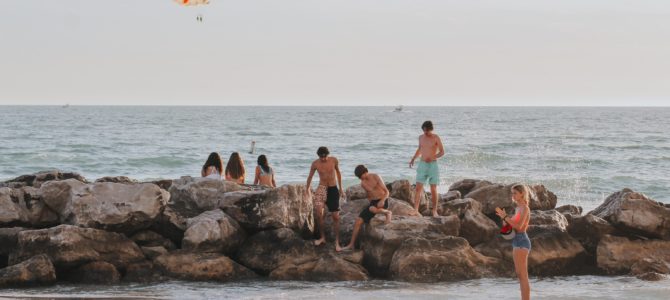
If your perception of the world is based on what corporate media tells you, you might think Florida is overrun by wild spring break revelers who are running around killing people by flaunting COVID precautions.
“How spring break in South Beach spun out of control,” the Washington Post blared. The Associated Press reported “deaths” and “violence,” while “police have arrested hundreds of partiers involved in violence and property destruction” in South Beach.
Business Insider lumped “street fights, arrests, and maskless crowds” together in its description of the debauchery. On March 20, the city of Miami Beach established a state of emergency, complete with an 8 p.m. weekend curfew.
The narrative that “Florida Gov. Ron DeSantis’ ‘open-for-business’ policy is backfiring in Miami Beach,” as Slate suggested, is as lazy as it is inaccurate. I’m sure there are some ne’er-do-wellers in Miami, as in any other place on earth. But the corporate media is so busy trying to dunk on DeSantis’s successful and freedom-centric COVID-19 response, they won’t tell you what’s really going on in the Sunshine State.
I’ve spent the past week in Florida, and visited beach towns on both the Atlantic and Gulf coasts. I’ve seen cheerful street musicians, sailboats unloading in marinas, kids on playgrounds, and moms pushing strollers in seersucker dresses. I’ve seen a few groups of what look like spring breakers too, walking down sunny sidewalks or sitting at beachfront bars enjoying fresh fried seafood.
In St. Petersburg, on Florida’s Gulf coast, the city recently finished rebuilding a pier that stretches out into Tampa Bay. Complete with playground, splash pad, restaurants, and palm trees, it’s a popular outdoor hub for locals and tourists.
Teenagers rollerblade down the boardwalk, while fishermen cast off the edge of the pier. People sit and dangle their bare feet over the water, practicing the old southern ritual of passing the time. A maskless street musician plays the accordion, while his dog retrieves dollar bills from the hands of delighted passersby.

Kayaks pass under the pier and jet skis speed around the bay. On the boardwalk, an older gentleman being pushed in a wheelchair is out for a stroll. “We’re open!” signs grace a few storefronts.
At the Saturday morning market, crowds buzz around tents buying farm produce, fresh-baked bread and fresh-squeezed orange juice, jewelry, art, and empanadas. Jenn Sperato mans the booth from the Habana Cafe, a local restaurant in Gulfport.
“Five dollars, honey,” she says as she hands out hot Cuban sandwiches and plantains. She asks another customer, clearly a regular, about her baby.
“Business keeps picking up,” she tells me. “You get tourists, but you’ll also have locals that will be here every week.”

Down on the beach, kids play in the sand and teenagers climb on rocks that jut out into the water. A few groups are taking family pictures. Behind them, a parasail glides by. An older lady walking her dog passes me on the sidewalk and grins, saying, “It’s so nice not to see masks!”
It’s a similar scene in New Smyrna Beach, just south of Daytona on the Atlantic side. A father-son duo heads out with their surfboards, while kids throw a football on the sand. People stand in line at an ice cream shop, while others skateboard or walk their dogs. Nearly a dozen American flags hang from the roof of a restaurant crowded with happy seafood connoisseurs.
Next door to a gas station selling boiled peanuts, an older couple sips wine on their balcony overlooking the street. Signs along the road announce sunrise Easter Sunday services on the beach, while others advertise outdoor movies.
At the Breakers, a rustic restaurant wedged between the beachfront and Flagler Avenue, young and old sit on barstools overlooking the water. Wide windows let in a salty breeze between hardwood plank walls, floor, and ceiling. Kids in swim shirts chow down on chicken tenders while retirees sit at the indoor bar watching a basketball game and chatting with waitresses.

Outside, a Jeep drives down the beach with an American flag waving behind it. A lone rooster wanders onto someone’s porch, while surf shops prop their doors open to let in the fresh air.
Locals and out-of-state visitors alike are enjoying the warm weather, open businesses, and freedom-loving attitudes of the Sunshine State. On the highway heading toward Tampa Bay, I saw license plates from Michigan, Kentucky, New York, Illinois, Georgia, Wisconsin, Indiana, Texas, Ohio, Tennessee, Pennsylvania, Alabama, Colorado, and North Carolina. An Indiana car was towing a boat, and I saw more plates coming from Gov. Andrew Cuomo’s New York than from any other state.
Normality is alive and well in Florida, as much as corporate media don’t want to admit it. Families with young kids are enjoying the open restaurants, beaches, and storefronts alongside retired couples and teenagers. I sense an attitude of friendliness, and camaraderie with strangers rather than fear of them. And there seems to be an extra abundant number of American flags.









